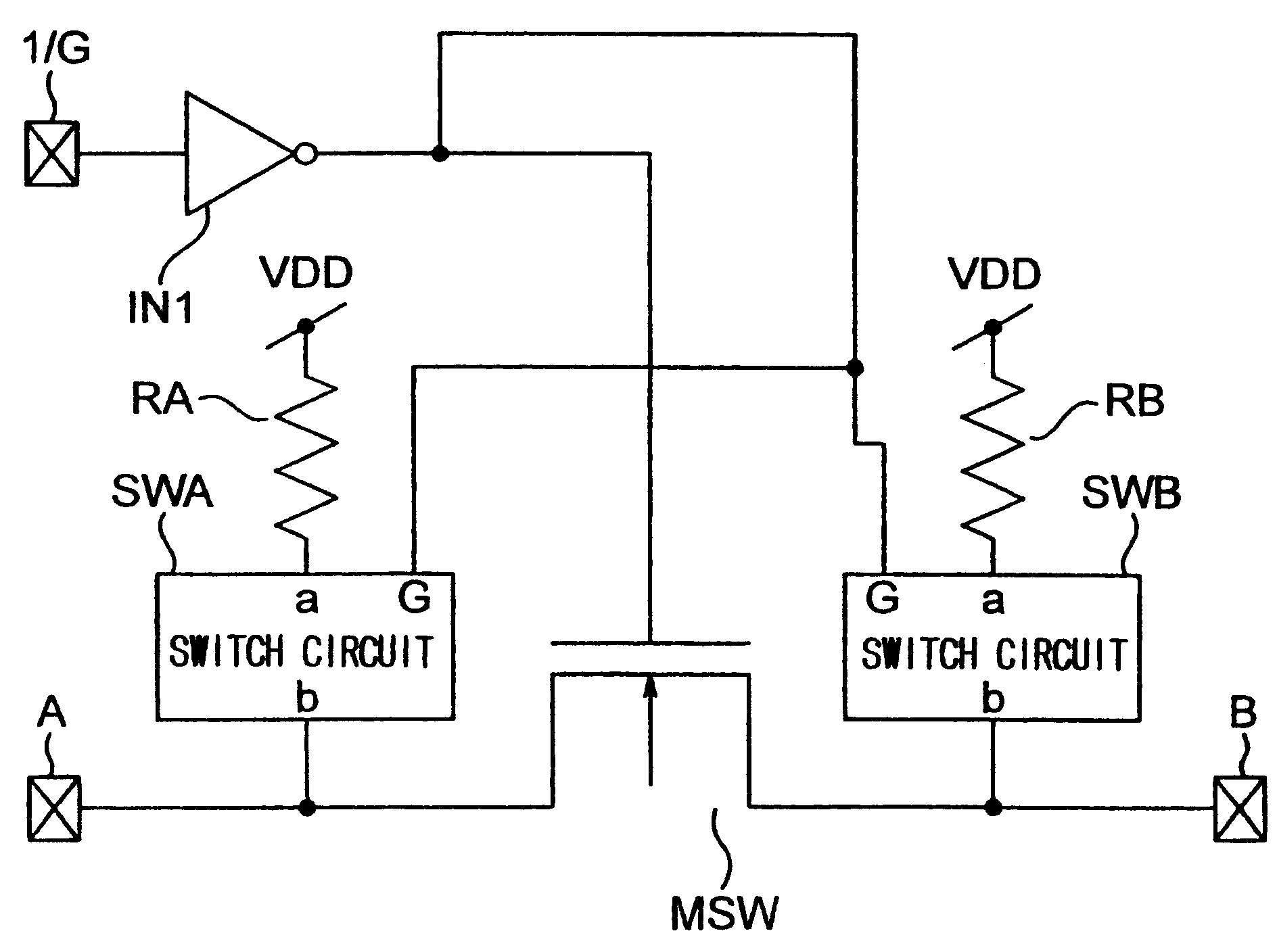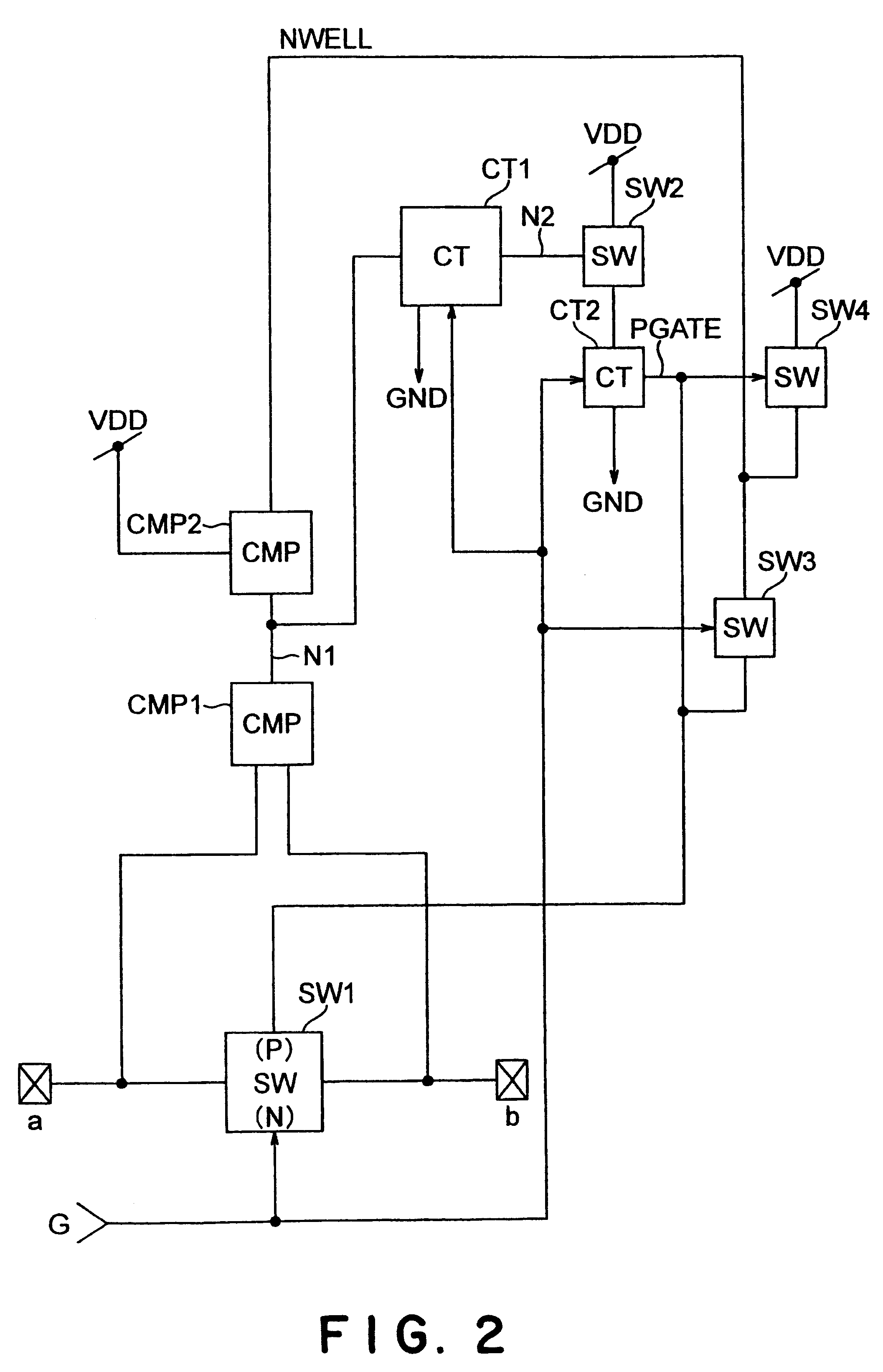Bus switch circuit and interactive level shifter
a switch circuit and level shifter technology, applied in the field of bus switch circuits and interactive level shifters, can solve the problems of signal delay, low propagation speed between terminals a and b, increase in cost,
- Summary
- Abstract
- Description
- Claims
- Application Information
AI Technical Summary
Benefits of technology
Problems solved by technology
Method used
Image
Examples
first embodiment
(1) First Embodiment
[0050]FIG. 2 shows the detailed circuit arrangement of a switch circuit SWA or SWB according to the first embodiment of the present invention.
[0051]A switch element SW1 having a CMOS structure formed from a p-channel transistor and n-channel transistor is connected between terminals a and b. The n-channel transistor is turned on / off by a control signal G (switch enable at high level and switch disable at low level). The p-channel transistor whose gate receives a gate signal PGATE is turned on in the switch enable mode and off in the switch disable mode, like the n-channel transistor.
[0052]The terminals a and b are connected to a comparator CMP1. The potentials of the terminals a and b are compared, and a higher potential is output to a node N1.
[0053]A comparator CMP2 compares the potential of the node N1 with a power supply voltage VDD. When the potential of the node N1 is equal to or higher than the power supply voltage VDD, the node N1 and n-well NWELL are conn...
second embodiment
(2) Second Embodiment
[0074]FIG. 3 shows the detailed circuit arrangement of a switch circuit SWA or SWB according to the second embodiment of the present invention.
[0075]The sources and drains of a p-channel transistor TR1 and n-channel transistor TR2, which form a switch element SW1, are connected between terminals a and b. The gate of the transistor TR1 is connected to a node PGATE. A control signal G is input to the gate of the transistor TR2.
[0076]The terminals of p-channel transistors TR3 and TR4 and n-channel transistor TR5 are connected in series between a power supply voltage VDD terminal and a ground terminal. The gate of the transistor TR3 is connected to a node P1. The control signal G is input to the gates of the transistors TR3 to TR5.
[0077]One terminal of a p-channel transistor TR6 is connected to an n-well NWELL. The control signal G is input to the gate of the transistor TR6. The other terminal is connected to the node PGATE.
[0078]One terminal of a p-channel transist...
third embodiment
(3) Third Embodiment
[0111]As another example of switch circuit SWA or SWB shown in FIG. 1, the third embodiment of the present invention will be described with reference to FIG. 4.
[0112]One terminal and the other terminal of each of p-channel transistor TR21 and n-channel transistor TR22 of the switch element of a CMOS circuit are connected in parallel between terminals a and b. A control signal G is input to the gate of the transistor TR22. The gate of the transistor TR21 is connected to a node GB.
[0113]The potential of the node GB is determined by the ON / OFF states of transistors TR25 and TR26. The terminals of the p-channel transistor TR25 and n-channel transistor TR26 are connected in series between an n-well NWELL1 and a ground terminal.
[0114]The potential of the node GB, which is determined by inputting the control signal G to the gates of the transistors TR25 and TR26, is input to the gate of the transistor TR21, thereby controlling electrical connection.
[0115]The terminals o...
PUM
 Login to View More
Login to View More Abstract
Description
Claims
Application Information
 Login to View More
Login to View More - R&D
- Intellectual Property
- Life Sciences
- Materials
- Tech Scout
- Unparalleled Data Quality
- Higher Quality Content
- 60% Fewer Hallucinations
Browse by: Latest US Patents, China's latest patents, Technical Efficacy Thesaurus, Application Domain, Technology Topic, Popular Technical Reports.
© 2025 PatSnap. All rights reserved.Legal|Privacy policy|Modern Slavery Act Transparency Statement|Sitemap|About US| Contact US: help@patsnap.com



